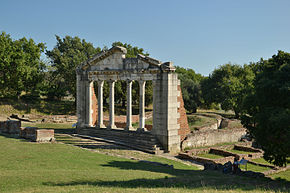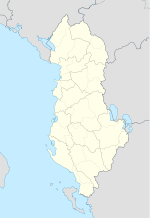Apollonia, Illyria

Monument of Agonothetes
|
|
| Location | Fier County, Albania |
|---|---|
| Region | Illyria |
| Coordinates | 40°43′N 19°28′E / 40.717°N 19.467°ECoordinates: 40°43′N 19°28′E / 40.717°N 19.467°E |
| Type | Settlement |
Apollonia (Ancient Greek: Ἀπολλωνία κατ᾿ Ἐπίδαμνον or Ἀπολλωνία πρὸς Ἐπίδαμνον, Apollonia kat' Epidamnon or Apollonia pros Epidamnon) was an ancient Greek city and former bishopric in Illyria. located on the right bank of the Aous river (modern-day Vjosë). Its ruins are situated in the Fier region, near the village of Pojani (Polina), in modern-day Albania. Apollonia was founded in 588 BCE by Greek colonists from Corfu and Corinth, on a site initially occupied by Illyrian tribes and was perhaps the most important of the several classical towns known as . Apollonia flourished in the Roman period and was home to a renowned school of philosophy, but began to decline in the 3rd century AD when its harbor started silting up as a result of an earthquake. It was abandoned by the end of Late Antiquity.
The name of the city is mentioned among the modern bishoprics of the (Apollonia and Fier). Apollonia is also a titular see of the Latin Church.
The site of Apollonia lay on the territory of the Taulantii, a cluster of Illyrian tribes that remained closely involved with the settlement for centuries and lived alongside the Greek colonists. The city was said to have originally been named Gylakeia after its founder, Gylax, but the name was later changed to honor the god Apollo.
It is mentioned by Strabo in his Geographica as "an exceedingly well-governed city".Aristotle considered Apollonia an important example of an oligarchic system, as the descendants of the Greek colonists controlled the city and prevailed over a large serf population of mostly Illyrian origin. The city grew rich on the slave trade and local agriculture, as well as its large harbour, said to have been able to hold a hundred ships at a time. The city also benefited from the local supply of asphalt which was a valuable commodity in ancient times, for example for caulking ships. The remains of a late sixth-century temple, located just outside the city, were reported in 2006; it is only the fifth known stone temple found in present-day Albania.
...
Wikipedia

